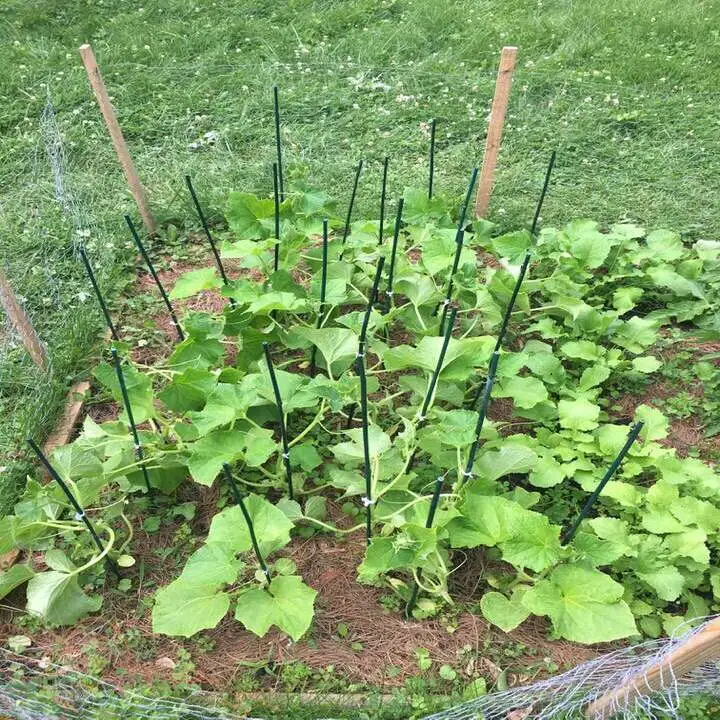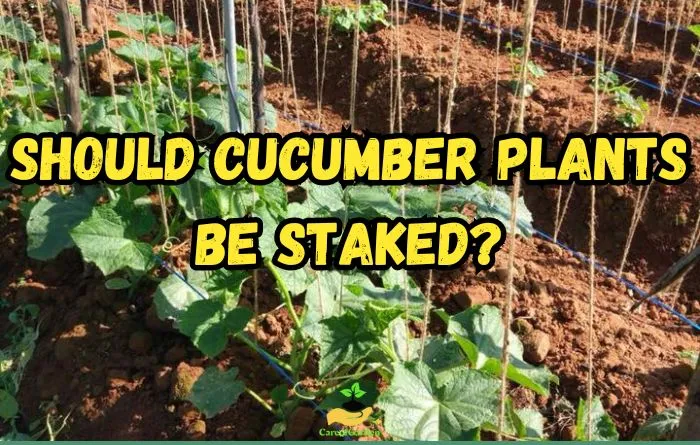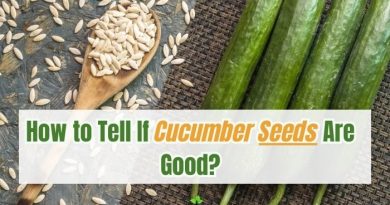Should Cucumber Plants Be Staked? Why It’s Important!
As an experienced gardener, I often get asked if cucumber plants should be staked. Truth be told, there is no right or wrong answer to this question, as it depends on various factors. In this article, I will give you the benefits of staking cucumber plants and provide guidance on when and how to stake them to help you make an informed decision about staking your cucumber plants.
Key Takeaways
- Staking cucumber plants can improve their overall health and yield
- Proper spacing, tying techniques, and ongoing maintenance are crucial for successful staking
- Staking and trellising are both effective methods for supporting cucumber plants
- When deciding whether to stake or not, consider your gardening preferences and space constraints
Should Cucumber Plants Be Staked?
Yes, cucumber plants should be staked to improve air circulation, prevent disease, and increase yields. It’s best to stake cucumbers when they are young to avoid disturbing the roots later on. Use sturdy stakes and tie the plants loosely to avoid damaging the stems.
The Benefits of Staking Cucumber Plants
Staking cucumber plants can have numerous benefits that aid in their growth, health, and yield.
Based on my experience, staking your cucumber plants can offer this compelling benefits:
- Improved Air Circulation: When cucumber plants are allowed to trail on the ground, they can become densely packed, which restricts air circulation. This can cause damp conditions that encourage the development of fungal diseases. Staking cucumber plants lifts them off the ground, allowing for better air circulation and reducing the risk of disease.
- Better Sun Exposure: Staked cucumber plants have better access to sunlight, which is crucial for photosynthesis and the production of healthy fruit.
- Easy Harvesting: Staked cucumber plants are easier to harvest because the fruit is elevated and easily visible. This saves time and effort when it comes to picking your crop.
- Increased Yield: Staked cucumber plants tend to produce larger and more abundant fruit due to the improved air circulation and sun exposure. This can result in a more bountiful harvest.
Overall, staking cucumber plants is a simple and effective way to improve their health and yield. Providing support to your plants can go a long way in creating a successful and thriving garden.
When and How to Stake Cucumber Plants

Staking cucumber plants is a crucial step towards obtaining high-quality yields. From my experience, staking should be done when the cucumber plants are about 12 to 18 inches tall. This is the best time to stake your plants to prevent them from sprawling on the ground and getting damaged.
You can also provide support to your cucumber plants while sowing the seeds by placing a stake next to where you plant them. This will help prevent root damage when staking the plants later.
Staking cucumber plants is easy, but it is important to use the right materials. Bamboo stakes for example make for a good option due to their durability, affordability and longevity.
My advice is to opt for stakes that are six feet in length to ensure adequate support, for your cucumbers as they continue to grow.
Insert the stake about six inches into the soil, one inch away from the base of the plant. Make sure it is inserted firmly to ensure it provides enough support.
As the plant grows, use plant ties or soft twine to secure it to the stake. This will provide additional support and prevent the plant from falling over.
It is important to monitor the plants regularly and adjust the ties as needed. This will prevent the ties from digging into the plants and causing injury or damage. Regular pruning may also be required to keep the plants in good condition and ensure they do not become too top-heavy.
Staking vs Trellising: Which is Better for Cucumber Plants?
When it comes to supporting cucumber plants, there are two main methods: staking and trellising.
I created the table below to give you an overview of the advantages and disadvantages of staking and trellising cucumbers:
| Staking Cucumbers | Advantages | Disadvantages |
|---|---|---|
| Improves air circulation around the plant, reducing disease | Requires more work to set up stakes and tie plants. | |
| Makes it easier to harvest cucumbers | Can cause damage to the plant if not staked properly | |
| Cucumbers are less likely to touch the ground, staying cleaner. | May not support heavy cucumber varieties or heavy fruit loads. | |
| Requires less horizontal space, ideal for smaller gardens. | Cucumbers may dry out more quickly due to sun exposure. | |
| A cost-effective method that requires minimal materials | Regular pruning is necessary to maintain your cucumber growth. |
| Trellising Cucumbers | Advantages | Disadvantages |
|---|---|---|
| Maximizes growing space and yield potential by using vertical space. | Is more difficult to set up and maintain | |
| Improves air circulation and reduces disease pressure | Can be more expensive to set up initially due to the investment in support structures. | |
| Keeps cucumbers off the ground, reducing soil-borne diseases | Can be more difficult to harvest cucumbers | |
| Cucumbers tend to grow straighter when trellised. | May require additional support for heavy fruit |
Staking involves driving a stake into the ground next to each plant and tying the stem to the stake as it grows. This method provides support for the plant to grow upwards rather than sprawling on the ground. Staking is ideal for gardeners with limited space, as it allows for tighter plant spacing and easier access for maintenance. Additionally, it is a cost-effective method that requires minimal materials.
Trellising, on the other hand, involves setting up a trellis or fence structure for the cucumber plants to climb as they grow. This method requires more space, as the plants need to be spaced farther apart to allow for upward growth. However, trellising can accommodate more plants in the same amount of space, making it more efficient for larger gardens. Trellises are often used for vining cucumbers, which need support for their tendrils to latch onto.
When deciding whether to stake or trellis your cucumber plants, it’s essential to consider your gardening preferences and space constraints. While trellising can be a space-saving option, staking may be more suitable if you have limited time or resources for ongoing maintenance.
Best Practices for Staking Cucumber Plants
Staking cucumber plants is an effective way to provide support and enhance the yield of your cucumber.
To ensure the success of your staked cucumber plants, here are some best practices I use frequently:
- Choose the right stakes: Select stakes that are sturdy, durable, and at least 6 feet tall. Bamboo or wooden stakes are good options.
- Space the plants properly: Space the plants at least 2 feet apart to allow for adequate airflow and sunlight.
- Plant the stakes correctly: Place the stakes 6 inches deep in the soil, at least 3-4 inches away from the plant stem.
- Secure the plants: Tie the plant to the stake using soft twine or plant ties, securing them loosely to allow for growth and flexibility.
- Monitor the plants: Regularly check the plants and adjust the ties as needed to prevent them from becoming too tight or causing damage.
- Prune the plants: Remove any lateral shoots or branches to allow the plant to focus its energy on growing the main stem and producing fruit.
- Harvest regularly: Pick the cucumbers promptly to encourage new growth and prevent the plant from becoming too heavy and breaking.
By following these best practices and tips, you can ensure the success of your staked cucumber plants and enjoy a bountiful harvest.
Conclusion
In conclusion, I believe that staking cucumber plants is a beneficial approach that can improve the health and yield of your garden.
By staking your plants, you can prevent them from becoming overcrowded and ensure they receive adequate support as they grow.
However, it’s important to stake your plants at the right time and with appropriate materials to avoid damaging their roots or causing other issues.
Frequently Asked Questions
Q: Should cucumber plants be staked?
Yes, staking cucumber plants can provide numerous benefits, including improved plant health and increased yield. Staking helps support the plants as they grow, preventing them from sprawling on the ground and reducing the risk of disease and pest infestation.
What are the benefits of staking cucumber plants?
A: Staking cucumber plants offers several advantages. It promotes better air circulation around the plants, reducing the likelihood of fungal diseases. Staking also keeps the fruits off the ground, preventing rot and making them easier to harvest. Additionally, staked plants receive more sunlight, leading to healthier growth and higher yields.
When and how should I stake cucumber plants?
It is best to stake cucumber plants when they are young and still developing. This can be done by inserting stakes or trellises into the ground next to the plants and tying them gently for support. The stakes should be sturdy and tall enough to accommodate the growth of the plants. As the cucumbers grow, gently tie them to the stakes using soft strips of cloth or plant ties.
Staking vs. trellising: Which method is better for cucumber plants?
Both staking and trellising can be effective methods for supporting cucumber plants, and the choice depends on your personal preference and gardening space. Staking involves using stakes or poles to provide support, while trellising involves using a framework or structure for the plants to climb. Staking is ideal for small gardens or limited spaces, whereas trellising is suitable for larger gardens or if you prefer a more vertical growth pattern for your cucumbers.
What are some best practices for staking cucumber plants?
To stake cucumber plants effectively, ensure proper spacing between plants to allow for airflow and prevent overcrowding. Use sturdy stakes or trellises that can support the weight of the plants and fruits. When tying the plants to the stakes, use soft materials such as cloth strips or plant ties to avoid damaging the stems. Regularly check the ties and adjust them as the plants grow. Lastly, provide regular watering and nutrients to support the healthy growth of your staked cucumber plants.




